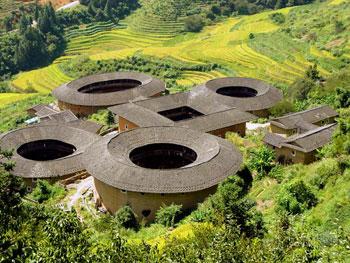Source: Xinhua
07-07-2008 09:22
QUEBEC CITY, July 6 (Xinhua) -- One more Chinese property was inscribed on the UNESCO's World Heritage List Sunday during the 32nd session of the World Heritage Committee that is taking place in this eastern Canadian city.
 |
| Tulou, the unique residential architecture of Fujian Province in southeastern China is inscribed on the UNESCO's World Heritage List Sunday during the 32nd session of the World Heritage Committee that is taking place in this eastern Canadian city Quebec. |
The 21 members of the committee agreed to add Tulou, the uniqueresidential architecture of Fujian Province in southeastern China, on the World Heritage List as a cultural site, bringing the total number of Chinese properties on the list to 36.
Built from the 11th century to the 20th century in the mountainous areas across Fujian and neighboring provinces, the Tulou buildings were aimed at meeting the requirements of a whole clan to live together. They also serve other functions such as defense.
![Tulou, the unique residential architecture of Fujian Province in southeastern China is inscribed on the UNESCO's World Heritage List Sunday during the 32nd session of the World Heritage Committee that is taking place in this eastern Canadian city Quebec. The photo is taken in October, 2002. [File Photo: Xinhua]](http://big5.cctv.com/gate/big5/www.cctv.cn/program/cultureexpress/20080707/images/1215394050215_1215394050215_r.jpg) |
| Tulou, the unique residential architecture of Fujian Province in southeastern China is inscribed on the UNESCO's World Heritage List Sunday during the 32nd session of the World Heritage Committee that is taking place in this eastern Canadian city Quebec.[File Photo: Xinhua] |
A Tulou building usually consists of rammed earth outer wall and internal wooden framework. Its unique structural form and ingenious interior design highlights the interdependent relation between clan members who live inside and demonstrates the development process of their life style.
In layout, the buildings nestled among hills and streams are harmonious with nature, reflecting Chinese traditional architectural designs, the Fengshui practices and the concept of unification between man and nature.
In addition, the Tulou buildings have nurtured local ways of production and lifestyles and fostered colorful intangible cultures.
In recommending the inscription of the Tulou buildings, ICOMOS, the professional evaluation institution of the World Heritage Committee, praised their breath-taking magnificence, unique and exquisite style as well as their durable and ingenious structure, saying they present a unique charm and outstanding universal value.
